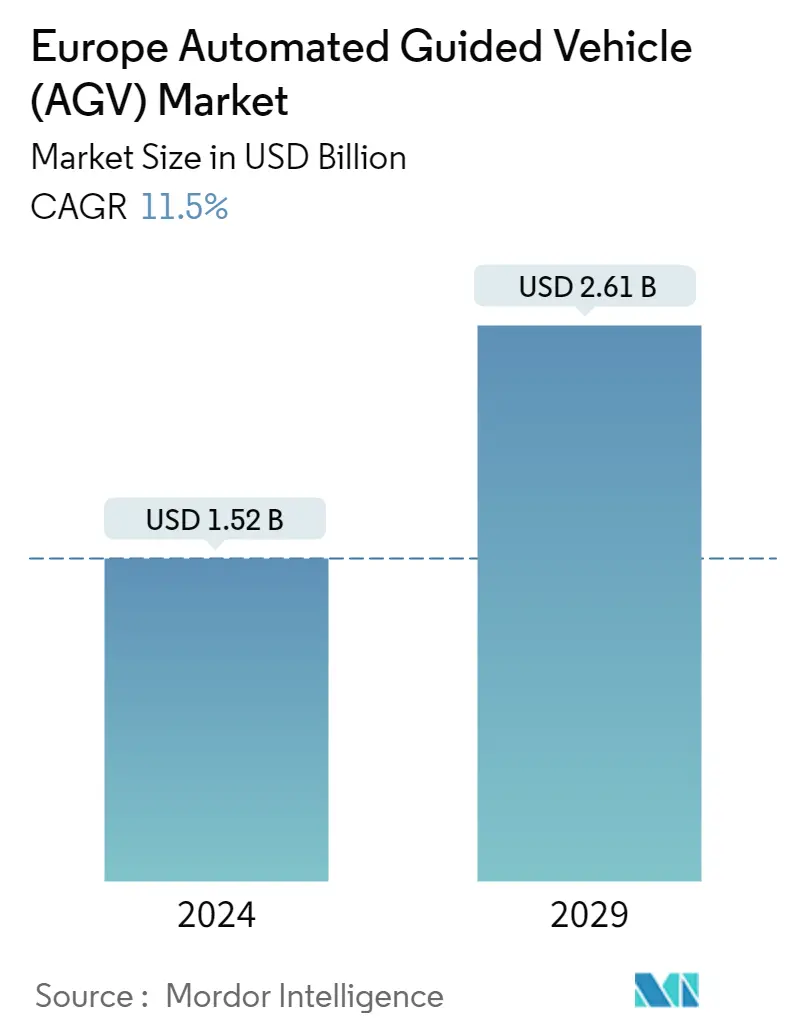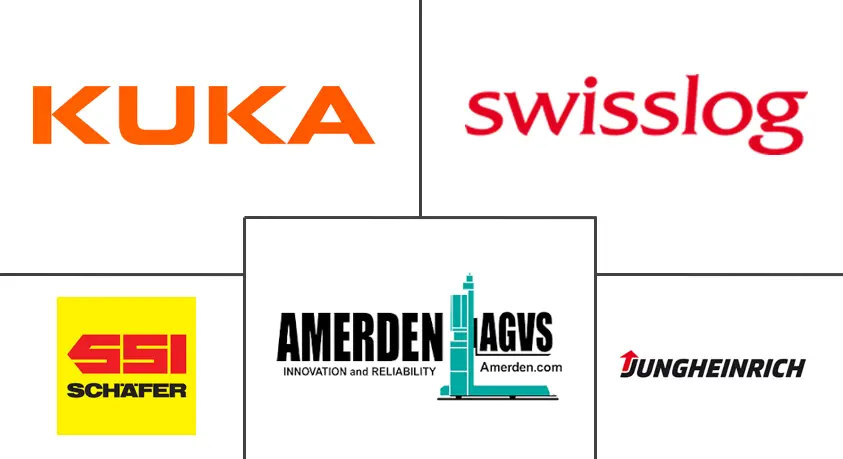Market Size of Europe Automated Guided Vehicle (AGV) Industry

| Study Period | 2019 - 2029 |
| Base Year For Estimation | 2023 |
| Market Size (2024) | USD 1.52 Billion |
| Market Size (2029) | USD 2.61 Billion |
| CAGR (2024 - 2029) | 11.50 % |
| Market Concentration | Low |
Major Players
*Disclaimer: Major Players sorted in no particular order |
Need a report that reflects how COVID-19 has impacted this market and its growth?
Europe AGV Market Analysis
The Europe Automated Guided Vehicle Market size is estimated at USD 1.52 billion in 2024, and is expected to reach USD 2.61 billion by 2029, growing at a CAGR of 11.5% during the forecast period (2024-2029).
The retail industry's growth is primarily driven by the increasing demand from e-commerce, primarily for automated warehouse solutions. Furthermore, the concentration of the market is expected to be focused in Western Europe; a majority of the turnover from the B2C platform is from the region (66%). Owing to such developments, vendors in the market are increasingly adopting automation.
- In July 2022, DHL eCommerce Solutions announced to invest EUR 560 million in DHL Parcel UK, its UK e-commerce operation. The investment follows a 40% increase in volume since the beginning of 2020 and increased demand for its e-commerce and B2B services. The expansion project intends to provide the necessary infrastructure to support development while positioning the company at the forefront of sustainable and digital logistics. Such developments in the region are driving the demand for AGVs.
- Industries, such as manufacturing, and food and beverage, are replacing human jobs with robots. However, unlike these industries, automation in the e-commerce sector creates better job opportunities. This is majorly due to the high usage of collaborative robots, such as AGVs, in the e-commerce fulfillment centers and the third-party warehousing sector.
- Moreover, the automotive industry is increasingly adopting automation and AGVs on its production floors. For instance, the SEAT plant in Martorell, Spain, is moving toward a digitalized smart factory, and the manufacturer adopted AGVs with SLAM navigation, 4 G connection, and induction battery charging. To date, the facility took eight AGVs for outdoor operation and had over 200 AGVs that deliver parts inside the assembly workshops at the Martorell and Barcelona factories. For instance, automotive supplier Brose invested EUR 2 million in AGVs, and the company provides seats and window regulators for auto manufacturers, such as Nissan, Jaguar, Land Rover, and Toyota.
- Further, the pharmaceutical industry is another prominent adopter of automation in its manufacturing space, as it is one of the highly regulated industries in the European region. For instance, Hoffmann-La Roche AG, a pharmaceutical company headquartered in Basel, Switzerland, implemented Industry 4.0 for the storage and picking of medications in its cold storage logistics facility at Roche's Kaiseraugst location. The storage warehouse has 8,100 pallet locations, and the facility adopted Swisslog's automation solutions. Over the coming years, vendors are expected to invest significantly in R&D related to charging and battery technologies while improving communication modules. With the advent of 5G, the operation of AGVs is expected to enhance, along with the adoption of high-speed communication modules.
- The demand for AGVs is primarily driven by the automotive, metal, healthcare, and pharmaceutical industries in the region. With the recent outbreak of COVID-19, the demand for automation is expected to increase over the long run, primarily to cope with the shortage of labor and increasing costs. The pharmaceutical industry, which has been deemed essential during the COVID-19 pandemic by governments across the region, has been driving demand for market growth.
- Businesses that use AGVs to automate their manufacturing processes or supply chains must spend heavily. This covers the cost of purchasing, installing, and modifying the workplace to make it more AGV-friendly. Furthermore, the hefty cost of high-end AGVs may discourage manufacturers from employing them. Because small businesses cannot afford automated systems, they must rely on traditional/manual forklift trucks, which may hinder AGV adoption among smaller firms.
